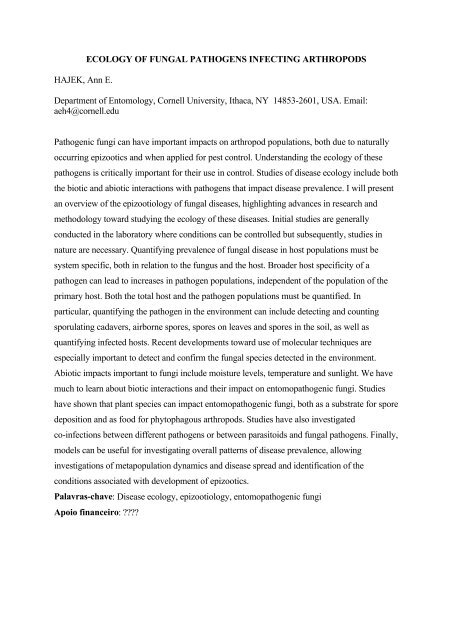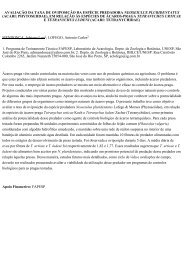Aplicação de feromônios no manejo de pragas em fruteiras de clima ...
Aplicação de feromônios no manejo de pragas em fruteiras de clima ...
Aplicação de feromônios no manejo de pragas em fruteiras de clima ...
Create successful ePaper yourself
Turn your PDF publications into a flip-book with our unique Google optimized e-Paper software.
HAJEK, Ann E.<br />
ECOLOGY OF FUNGAL PATHOGENS INFECTING ARTHROPODS<br />
Department of Entomology, Cornell University, Ithaca, NY 14853-2601, USA. Email:<br />
aeh4@cornell.edu<br />
Pathogenic fungi can have important impacts on arthropod populations, both due to naturally<br />
occurring epizootics and when applied for pest control. Un<strong>de</strong>rstanding the ecology of these<br />
pathogens is critically important for their use in control. Studies of disease ecology inclu<strong>de</strong> both<br />
the biotic and abiotic interactions with pathogens that impact disease prevalence. I will present<br />
an overview of the epizootiology of fungal diseases, highlighting advances in research and<br />
methodology toward studying the ecology of these diseases. Initial studies are generally<br />
conducted in the laboratory where conditions can be controlled but subsequently, studies in<br />
nature are necessary. Quantifying prevalence of fungal disease in host populations must be<br />
syst<strong>em</strong> specific, both in relation to the fungus and the host. Broa<strong>de</strong>r host specificity of a<br />
pathogen can lead to increases in pathogen populations, in<strong>de</strong>pen<strong>de</strong>nt of the population of the<br />
primary host. Both the total host and the pathogen populations must be quantified. In<br />
particular, quantifying the pathogen in the environment can inclu<strong>de</strong> <strong>de</strong>tecting and counting<br />
sporulating cadavers, airborne spores, spores on leaves and spores in the soil, as well as<br />
quantifying infected hosts. Recent <strong>de</strong>velopments toward use of molecular techniques are<br />
especially important to <strong>de</strong>tect and confirm the fungal species <strong>de</strong>tected in the environment.<br />
Abiotic impacts important to fungi inclu<strong>de</strong> moisture levels, t<strong>em</strong>perature and sunlight. We have<br />
much to learn about biotic interactions and their impact on entomopathogenic fungi. Studies<br />
have shown that plant species can impact entomopathogenic fungi, both as a substrate for spore<br />
<strong>de</strong>position and as food for phytophagous arthropods. Studies have also investigated<br />
co-infections between different pathogens or between parasitoids and fungal pathogens. Finally,<br />
mo<strong>de</strong>ls can be useful for investigating overall patterns of disease prevalence, allowing<br />
investigations of metapopulation dynamics and disease spread and i<strong>de</strong>ntification of the<br />
conditions associated with <strong>de</strong>velopment of epizootics.<br />
Palavras-chave: Disease ecology, epizootiology, entomopathogenic fungi<br />
Apoio financeiro: ????






